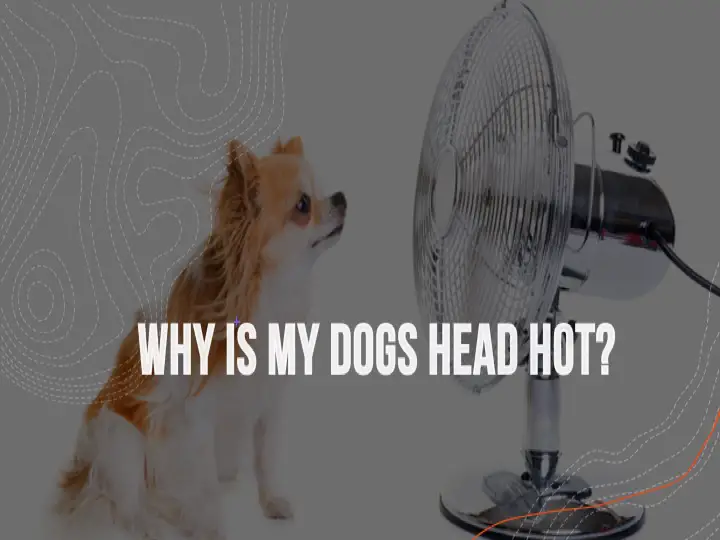My Dog’s Head is Hot, Should I Be Worried?
Table of Contents
Dogs don’t sweat (perspire) like humans, but they do release heat through their paws and the pads on the underside of their tongues. When it’s hot outside, or during periods of high physical activity, dogs need to find ways to cool down. One way dogs can do this is by releasing heat through their heads.
Blood Vessels in a Dog’s Head
A dog’s blood vessels in their head are closer to the skin than those in its body; allowing for more efficient cooling of the blood flow within them. Think of it like air conditioning – if you put cooler air near the warm air in a room, the cool air will spread out and take over the entire room. The same thing happens when that cooler blood reaches your dog’s body.
One Thing You Need To Ask Your Dog Breeder
Is My Dog Sick if His Head is Hot?
If your dog’s head is hot, don’t panic; it doesn’t necessarily mean he has a fever. A fever occurs when there is an increase in body temperature of at least one degree Fahrenheit (or 0.6 degrees Celsius) for more than 12 hours, and it’s only considered a symptom of illness if accompanied by other symptoms.
It could be that your dog is sick or had too much physical activity on a hot day. If your dog is panting heavily or drooling excessively, you need to cool him down with water and take him inside immediately so he can rest in an air-conditioned environment until his breathing returns to normal.
What Causes My Dog’s Head to be Hot?
There are several things that can cause your dog’s head to be hot. The most common cause of a hot head is too much exercise on a hot day. However, there are other possible reasons for your dog’s head being extremely warm to the touch:
- High blood pressure
- Improper body weight (overweight)
- Old age
- Anxiety or stress from being in a strange location or around new people
- Skin infection
- Medications such as antibiotics and heartworm pills, can raise your dog’s temperature slightly If you suspect this is the case with your pet, call your vet immediately.
7 Reasons Why Dog’s Heads Gets Hot
- A dog’s head is made of a lot of muscle. The more muscle, the higher temperature is needed to keep things going smoothly. If you do not see your dog panting, they are trying to cool themselves down through their heads because they are not being cooled down through their tongue.
- Dogs have fewer sweat glands than people do. They need to pant more to cool themselves down. A dog’s sweat glands are closer to the surface of their skin than people’s. This makes it easier for them to cool off, as the air can more effectively evaporate (carry away as steam) their sweat as they release it through panting or increased temperatures in their head.
- Dogs are more likely to have diseases that make it harder for them to sweat, making even more difficult for them to keep themselves cool. This can be very dangerous if they are not seeking shade when outside on hot days. If their head is hot while outside, bring them in for a rest.
- Dogs have a much larger blood flow going to their brains than people do, which also heats up their heads. Since they must maintain a constant body temperature above that of humans, they need extra ways to cool themselves when needed.
- Dogs also don’t regulate their temperature as well as we do because they lack the part in the brain that we have that tells us when we need to cool down. This can cause them to overheat and cause serious problems if they are not allowed to find a way to cool off.
- Dogs have fur on their heads which can keep their head hotter to the touch than ours are. Some dogs also have wrinkly skin on their head that may trap heat, allowing them to get hotter faster than other dogs.
- Dogs have a lot less fat than humans do, and fat is what keeps us insulated. Without insulation dogs can freeze to death just as easily as they can overheat on hot days.
What is a Normal Temperature for Dogs?
A normal temperature for dogs is 100 to 102.5 degrees Fahrenheit (38-39.2 Celsius). Their body temperatures fluctuate during the day, and it’s not unusual for their temperatures to range between 99 and 104 degrees Fahrenheit (37.2-40 Celsius) on a hot day.
What Can I Do to Help My Dog Stay Cool?
There are several things you can do to help your dog stay cool and comfortable during warm weather:
- Try to keep them indoors in an air-conditioned environment when the temperatures outside get too high. When bringing them in for a rest, be sure not to leave them confined in a small area where they might overheat. Make sure they have plenty of fresh, cool water to drink.
- Bring them in from the heat before they become exhausted and begin to overheat! If your dog is not breathing well when you bring him inside after being outside on a hot day, he may have a condition that needs immediate attention from a veterinarian.
Signs of a breathing problem in dogs include:
- Panting heavily and trying to get cool by sitting in a tub of water or under a fan
- Trying to sit close to an air vent or open window when inside your house
- Rapid shallow breathing (they may also breathe fast when sleeping; this is normal)
Exercise should only be done early in the morning or in the evening when the temperatures are lower. If you feel your dog is becoming overheated, stop what you’re doing and get them out of the heat.
Dogs that regularly pant heavily should be checked by a veterinarian if they don’t start to improve within 15 minutes or so; the same applies if they act like they are choking or gasping with their mouth open. These could be signs of a heart problem.
My Dog Has a High Temperature, What Should I Do?
An extremely high temperature (e.g., 104°F and above) is a medical emergency and your dog will need to receive immediate veterinary care.
If you suspect that your dog may be overheated, call your veterinarian and take your pet’s temperature before heading out to the clinic. It is important to not use a traditional glass mercury thermometer in dogs because of the risk of breaking the glass and getting toxic levels of mercury in your pet; you can find several types of electronic canine thermometers to use instead.
Conclusion: Why is My Dog’s Head Hot?
Since dogs have a much larger blood flow going to their heads than we do, combined with the fact that they don’t regulate their body temperature as well as we do and lack insulation, it is common for our dogs’ heads to heat up more quickly than ours. This can cause them to pant heavily and get red in the face.
There are several things that you can do to help your dog in this situation. They should have plenty of fresh water to drink, be brought in from hot weather before they begin to overheat, and kept away from exercise during the hottest parts of the day. If their temperature remains high after 2 hours, or if they are panting heavily or gasping for breath when resting, they will need to be taken in for veterinary care.


